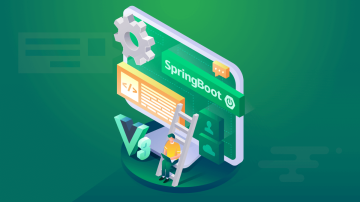本文提供了全面的Spring Boot企业级开发资料,涵盖了从环境搭建到实战应用的各个层面。内容包括开发环境配置、快速创建项目、核心功能详解以及数据库集成、Web服务开发、安全与权限管理、日志与监控等模块。文章通过示例代码和详细步骤,帮助开发者深入了解和掌握Spring Boot的各项特性。
Spring Boot简介与环境搭建Spring Boot介绍
Spring Boot是由Pivotal团队提供的一个开源框架,其主要目标是简化新Spring应用的初始搭建以及开发过程。Spring Boot可以在没有Spring配置的情况下运行,它通过自动配置、内置的Web服务器、开箱即用的生产就绪特性等功能,使开发者更加专注于业务逻辑的实现。
Spring Boot具有以下特性:
- 独立运行:无需外部依赖,可以独立运行
- 自动配置:自动配置了许多常用的框架和库
- 内嵌Web服务器:嵌入了Tomcat、Jetty或Undertow等Web服务器
- 简化Maven/Gradle配置:内置了默认配置,减少了配置的复杂性
- 工具支持:支持自动重启功能、内嵌配置文件等
- 无代码生成:无需生成配置文件或XML文件
开发环境配置
要开发Spring Boot应用,首先需要安装Java开发环境,并确保环境变量已正确配置。
安装Java开发环境
- Java JDK:下载并安装最新版本的Java JDK,如Java 11或更高版本。
- 环境变量配置:设置
JAVA_HOME环境变量到JDK安装目录,并确保PATH包含%JAVA_HOME%\bin。
示例代码(环境变量配置):
set JAVA_HOME=C:\Program Files\Java\jdk-11
set PATH=%JAVA_HOME%\bin;%PATH%安装Maven
- 下载Maven:从 Maven 官方网站下载并安装 Maven。
- 配置环境变量:设置
MAVEN_HOME环境变量到Maven安装目录,并确保PATH包含%MAVEN_HOME%\bin。
示例代码(环境变量配置):
set MAVEN_HOME=C:\Program Files\apache-maven-3.8.1
set PATH=%MAVEN_HOME%\bin;%PATH%安装IDE
使用支持Java开发的IDE,如 IntelliJ IDEA 或 Eclipse。
- IntelliJ IDEA:下载并安装 IntelliJ IDEA,确保 IDE 已安装了 Java 插件和 Maven 插件。
- Eclipse:下载并安装 Eclipse,确保 IDE 已安装了 Java 插件和 Maven 插件。
快速创建Spring Boot项目
使用 Spring Initializr 快速创建Spring Boot项目:
- 访问 Spring Initializr 网站(https://start.spring.io/)。
- 选择项目的基本信息:
- Project:Maven Project
- Language:Java
- Spring Boot:使用当前提供版本
- Project Metadata:项目名、组织名、描述等
- 选择项目依赖:
- Dependencies:选择所需的依赖,如Spring Web、Spring Data JPA等
- 点击“Generate”按钮,下载生成的项目文件夹。
- 解压下载的文件夹,导入到IDE中。
示例代码:
<project xmlns="http://maven.apache.org/POM/4.0.0" xmlns:xsi="http://www.w3.org/2001/XMLSchema-instance"
xsi:schemaLocation="http://maven.apache.org/POM/4.0.0 http://maven.apache.org/xsd/maven-4.0.0.xsd">
<modelVersion>4.0.0</modelVersion>
<groupId>com.example</groupId>
<artifactId>demo</artifactId>
<version>0.0.1-SNAPSHOT</version>
<name>demo</name>
<description>Demo project for Spring Boot</description>
<parent>
<groupId>org.springframework.boot</groupId>
<artifactId>spring-boot-starter-parent</artifactId>
<version>2.7.8</version>
</parent>
<dependencies>
<dependency>
<groupId>org.springframework.boot</groupId>
<artifactId>spring-boot-starter-web</artifactId>
</dependency>
<dependency>
<groupId>org.springframework.boot</groupId>
<artifactId>spring-boot-starter-data-jpa</artifactId>
</dependency>
<dependency>
<groupId>com.h2database</groupId>
<artifactId>h2</artifactId>
</dependency>
</dependencies>
<build>
<plugins>
<plugin>
<groupId>org.springframework.boot</groupId>
<artifactId>spring-boot-maven-plugin</artifactId>
</plugin>
</plugins>
</build>
</project>自动配置与依赖管理
Spring Boot通过自动配置和依赖管理简化开发过程。自动配置使开发者无需编写繁琐的配置代码,而是通过注解和配置文件来自动配置应用。
自动生成的配置
Spring Boot会根据类路径上的依赖自动配置应用。例如,添加了spring-boot-starter-web依赖,Spring Boot会自动配置一个嵌入的Tomcat服务器和Spring MVC。
示例代码(自动配置):
<dependency>
<groupId>org.springframework.boot</groupId>
<artifactId>spring-boot-starter-web</artifactId>
</dependency>依赖管理
Spring Boot父POM会自动管理依赖版本,避免版本冲突。通过继承父POM,子项目可以继承父POM的依赖管理。
示例代码(父POM配置):
<parent>
<groupId>org.springframework.boot</groupId>
<artifactId>spring-boot-starter-parent</artifactId>
<version>2.7.8</version>
</parent>
``
### Spring Boot Starter的使用
Spring Boot Starter 是一组可快速配置的依赖集合,使用这些依赖可以快速开发一个可运行的Spring应用。常用的Starter包括:
- `spring-boot-starter-web`:用于开发Web应用
- `spring-boot-starter-data-jpa`:用于开发基于JPA的数据访问应用
- `spring-boot-starter-security`:用于开发安全应用
示例代码(Starter配置):
```xml
<dependencies>
<dependency>
<groupId>org.springframework.boot</groupId>
<artifactId>spring-boot-starter-web</artifactId>
</dependency>
<dependency>
<groupId>org.springframework.boot</groupId>
<artifactId>spring-boot-starter-data-jpa</artifactId>
</dependency>
<dependency>
<groupId>org.springframework.boot</groupId>
<artifactId>spring-boot-starter-security</artifactId>
</dependency>
</dependencies>配置文件详解(application.properties/application.yml)
Spring Boot支持使用application.properties或application.yml来配置应用的属性。
application.properties
server.port=8080
spring.datasource.url=jdbc:mysql://localhost:3306/dbname
spring.datasource.username=root
spring.datasource.password=rootapplication.yml
server:
port: 8080
spring:
datasource:
url: jdbc:mysql://localhost:3306/dbname
username: root
password: rootSpring Data JPA简介与使用
Spring Data JPA 是Spring Data项目的一部分,用于简化JPA(Java Persistence API)的使用。它提供了CRUD操作、分页、排序等功能,并兼容多种数据库。
依赖添加
在pom.xml中添加spring-boot-starter-data-jpa依赖。
示例代码(JPA依赖):
<dependency>
<groupId>org.springframework.boot</groupId>
<artifactId>spring-boot-starter-data-jpa</artifactId>
</dependency>数据库连接配置
在application.properties或application.yml中配置数据库连接信息。
示例代码(数据库连接配置):
spring.datasource.url=jdbc:mysql://localhost:3306/dbname
spring.datasource.username=root
spring.datasource.password=root实体类和Repository接口定义
创建实体类和JPA Repository接口。
示例代码(实体类):
import javax.persistence.Entity;
import javax.persistence.GeneratedValue;
import javax.persistence.GenerationType;
import javax.persistence.Id;
@Entity
public class User {
@Id
@GeneratedValue(strategy=GenerationType.AUTO)
private Long id;
private String name;
private String email;
// Getters and Setters
}示例代码(Repository接口):
import org.springframework.data.jpa.repository.JpaRepository;
public interface UserRepository extends JpaRepository<User, Long> {
}数据库操作示例
通过Repository接口进行数据库操作。
示例代码(数据库操作):
import org.springframework.beans.factory.annotation.Autowired;
import org.springframework.stereotype.Service;
@Service
public class UserService {
@Autowired
private UserRepository userRepository;
public User saveUser(User user) {
return userRepository.save(user);
}
public User findUserById(Long id) {
return userRepository.findById(id).orElse(null);
}
}创建RESTful API
使用Spring Boot创建RESTful API服务。
创建Controller
创建一个Controller类处理HTTP请求。
示例代码(Controller创建):
import org.springframework.web.bind.annotation.*;
@RestController
@RequestMapping("/users")
public class UserController {
@Autowired
private UserService userService;
@GetMapping("/{id}")
public User getUserById(@PathVariable Long id) {
return userService.findUserById(id);
}
@PostMapping("/")
public User createUser(@RequestBody User user) {
return userService.saveUser(user);
}
}控制器开发与测试
使用Postman等工具测试API接口。
示例代码(Controller测试):
import org.springframework.beans.factory.annotation.Autowired;
import org.springframework.boot.CommandLineRunner;
import org.springframework.boot.SpringApplication;
import org.springframework.boot.autoconfigure.SpringBootApplication;
@SpringBootApplication
public class DemoApplication implements CommandLineRunner {
@Autowired
private UserService userService;
public static void main(String[] args) {
SpringApplication.run(DemoApplication.class, args);
}
@Override
public void run(String... args) throws Exception {
User user = new User();
user.setName("John Doe");
user.setEmail("john.doe@example.com");
userService.saveUser(user);
}
}响应式编程与WebFlux介绍
Spring WebFlux是Spring Boot 2.x版本引入的响应式Web框架。它基于Reactor库,支持非阻塞I/O和响应式编程。
创建WebFlux应用
示例代码(WebFlux创建):
import org.springframework.boot.SpringApplication;
import org.springframework.boot.autoconfigure.SpringBootApplication;
import org.springframework.web.reactive.function.server.RouterFunction;
import org.springframework.web.reactive.function.server.RouterFunctions;
import org.springframework.web.reactive.function.server.ServerResponse;
@SpringBootApplication
public class WebFluxApplication {
public static void main(String[] args) {
SpringApplication.run(WebFluxApplication.class, args);
}
@Bean
public RouterFunction<ServerResponse> route() {
return RouterFunctions.route()
.GET("/users", this::getUserById)
.POST("/users", this::createUser)
.build();
}
public Mono<ServerResponse> getUserById(ServerRequest request) {
Long id = Long.parseLong(request.pathVariable("id"));
return ServerResponse.ok().body(userService.findUserById(id), User.class);
}
public Mono<ServerResponse> createUser(ServerRequest request) {
return request.bodyToMono(User.class)
.flatMap(user -> ServerResponse.ok().body(userService.saveUser(user), User.class));
}
}Spring Security集成与配置
Spring Security 是Spring框架的一个安全模块,用于保护应用免受未授权访问。它支持多种认证和授权策略。
添加依赖
在pom.xml中添加spring-boot-starter-security依赖。
示例代码(安全依赖添加):
<dependency>
<groupId>org.springframework.boot</groupId>
<artifactId>spring-boot-starter-security</artifactId>
</dependency>安全配置
创建一个安全配置类,继承WebSecurityConfigurerAdapter。
示例代码(安全配置类):
import org.springframework.context.annotation.Configuration;
import org.springframework.security.config.annotation.web.builders.HttpSecurity;
import org.springframework.security.config.annotation.web.configuration.EnableWebSecurity;
import org.springframework.security.config.annotation.web.configuration.WebSecurityConfigurerAdapter;
@Configuration
@EnableWebSecurity
public class SecurityConfig extends WebSecurityConfigurerAdapter {
@Override
protected void configure(HttpSecurity http) throws Exception {
http
.authorizeRequests()
.antMatchers("/users/**").permitAll()
.anyRequest().authenticated()
.and()
.httpBasic();
}
}用户认证与授权
使用Spring Security的认证功能,允许特定用户访问资源。
示例代码(用户认证配置):
import org.springframework.security.core.userdetails.User;
import org.springframework.security.core.userdetails.UserDetailsService;
import org.springframework.security.core.userdetails.UsernameNotFoundException;
import org.springframework.security.crypto.bcrypt.BCryptPasswordEncoder;
import org.springframework.security.crypto.password.PasswordEncoder;
import org.springframework.security.provisioning.InMemoryUserDetailsManager;
@Configuration
public class SecurityConfig {
@Autowired
public void configureGlobal(AuthenticationManagerBuilder auth) throws Exception {
PasswordEncoder encoder = new BCryptPasswordEncoder();
auth.inMemoryAuthentication()
.withUser("user").password(encoder.encode("password")).roles("USER")
.and()
.withUser("admin").password(encoder.encode("password")).roles("ADMIN");
}
}配置CSRF保护和Session管理
CSRF保护
启用CSRF保护,防止跨站请求伪造攻击。
示例代码(CSRF保护配置):
import org.springframework.context.annotation.Configuration;
import org.springframework.security.config.annotation.web.builders.HttpSecurity;
import org.springframework.security.config.annotation.web.configuration.EnableWebSecurity;
import org.springframework.security.config.annotation.web.configuration.WebSecurityConfigurerAdapter;
@Configuration
@EnableWebSecurity
public class SecurityConfig extends WebSecurityConfigurerAdapter {
@Override
protected void configure(HttpSecurity http) throws Exception {
http
.authorizeRequests()
.antMatchers("/users/**").permitAll()
.anyRequest().authenticated()
.and()
.csrf().disable()
.httpBasic();
}
}Session管理
配置Session管理,控制Session的有效期和行为。
示例代码(Session管理配置):
import org.springframework.context.annotation.Bean;
import org.springframework.context.annotation.Configuration;
import org.springframework.security.web.session.HttpSessionEventPublisher;
@Configuration
public class SecurityConfig {
@Bean
public HttpSessionEventPublisher httpSessionEventPublisher() {
return new HttpSessionEventPublisher();
}
}日志管理(SLF4J,Logback)
Spring Boot默认使用SLF4J和Logback作为日志框架。
配置日志级别
在application.properties或application.yml中配置日志级别。
示例代码(日志级别配置):
# application.properties
logging.level.root=INFO
logging.level.com.example=DEBUG# application.yml
logging:
level:
root: INFO
com.example: DEBUG使用Logback配置文件
可以自定义Logback配置文件logback-spring.xml。
示例代码(Logback配置文件):
<configuration>
<appender name="STDOUT" class="ch.qos.logback.core.ConsoleAppender">
<encoder>
<pattern>%d{HH:mm:ss.SSS} [%thread] %-5level %logger{36} - %msg%n</pattern>
</encoder>
</appender>
<root level="info">
<appender-ref ref="STDOUT" />
</root>
</configuration>应用监控工具(Micrometer, Prometheus)
Spring Boot Actuator提供了一组预定义的端点,用于监控和管理应用。Micrometer是Spring Boot推荐的监控库,支持多种监控后端,如Prometheus、Grafana等。
添加依赖
在pom.xml中添加Micrometer依赖。
示例代码(Micrometer依赖添加):
<dependency>
<groupId>io.micrometer</groupId>
<artifactId>micrometer-registry-prometheus</artifactId>
</dependency>配置Prometheus
在application.properties或application.yml中配置Prometheus监控。
示例代码(Prometheus配置):
# application.properties
management.endpoints.web.exposure.include=prometheus
management.metrics.web.server.request-time-quantiles=0.5, 0.95# application.yml
management:
endpoints:
web:
exposure:
include: prometheus
metrics:
web:
server:
request-time-quantiles: 0.5, 0.95Actuator端点配置与使用
Actuator提供了一系列管理端点,可以用来获取应用的运行时信息,如健康检查、环境信息等。
启用Actuator端点
在pom.xml中添加spring-boot-starter-actuator依赖。
示例代码(Actuator依赖添加):
<dependency>
<groupId>org.springframework.boot</groupId>
<artifactId>spring-boot-starter-actuator</artifactId>
</dependency>配置Actuator端点
在application.properties或application.yml中配置Actuator端点。
示例代码(Actuator端点配置):
# application.properties
management.endpoints.web.exposure.include=health,info
management.endpoint.health.show-details=always# application.yml
management:
endpoints:
web:
exposure:
include: health,info
endpoint:
health:
show-details: always访问Actuator端点
启动应用后,访问/actuator/health和/actuator/info等端点获取应用信息。
示例代码(Actuator端点使用):
import org.springframework.boot.SpringApplication;
import org.springframework.boot.autoconfigure.SpringBootApplication;
import org.springframework.boot.actuate.health.HealthEndpoint;
import org.springframework.boot.actuate.health.HealthEndpointComposite;
import org.springframework.boot.actuate.info.InfoProperties;
import org.springframework.boot.actuate.info.InfoContributor;
import org.springframework.boot.actuate.info.InfoContributorRegistry;
import org.springframework.boot.actuate.info.InfoPropertiesCustomizer;
import org.springframework.boot.actuate.info.InfoPropertiesCustomizerRegistry;
import org.springframework.context.annotation.Bean;
@SpringBootApplication
public class ActuatorApplication {
public static void main(String[] args) {
SpringApplication.run(ActuatorApplication.class, args);
}
@Bean
public InfoPropertiesCustomizer customizer() {
return new InfoPropertiesCustomizer() {
@Override
public void customize(InfoProperties properties) {
properties.setApp("myapp");
}
};
}
}通过上述配置和代码示例,你已经能够掌握Spring Boot项目的基本开发和管理。希望这些知识和实践对你有所帮助。如有需要,可以继续深入学习Spring Boot的更多高级功能。

 随时随地看视频
随时随地看视频




